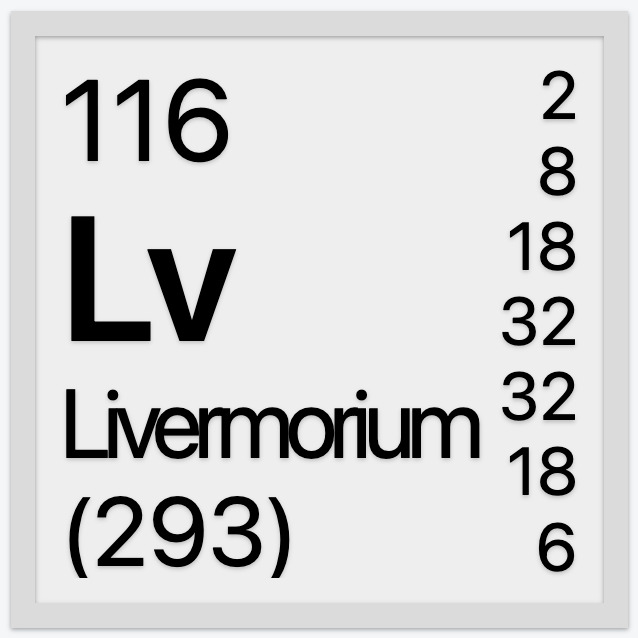 Livermore is one of just a handful of cities in the world to have an element named after it — livermorium. The first few atoms of element 116 were synthesized in 2000 by scientists at the Joint Institute for Nuclear Research in Dubna, Russia, working in collaboration with a team based here at the Lawrence Livermore National Laboratory. Livermorium Plaza commemorates the achievement, appropriately located at 116 S. Livermore Ave. Representing the nucleus of a livermorium atom, the Kugel fountain features a 5 foot diameter, 18,000 pound granite sphere that is suspended on a thin cushion of water.
Livermore is one of just a handful of cities in the world to have an element named after it — livermorium. The first few atoms of element 116 were synthesized in 2000 by scientists at the Joint Institute for Nuclear Research in Dubna, Russia, working in collaboration with a team based here at the Lawrence Livermore National Laboratory. Livermorium Plaza commemorates the achievement, appropriately located at 116 S. Livermore Ave. Representing the nucleus of a livermorium atom, the Kugel fountain features a 5 foot diameter, 18,000 pound granite sphere that is suspended on a thin cushion of water.
Like other super-heavy elements, livermorium does not occur naturally on Earth. It takes an enormous amount of energy (and luck) to create just a few atoms of livermorium. Furthermore, livermorium is extremely unstable, with isotopes lasting only milliseconds or even microseconds before radioactive decay causes it to transform into flerovium, which then rapidly decays further into a series of other unstable radioactive elements.
So what exactly is the recipe for creating a new element like livermorium? It involves a complex process known as nuclear fusion. The atomic number of an element (and its position on the periodic table) is determined by the number of protons in the nucleus. Hydrogen has just 1 proton, and thus has the atomic number 1. Carbon has 6 protons, gold has 79. In order to create livermorium (atomic number 116), the Livermore team of scientists supplied a target made of curium (atomic number 96), and then the Dubna team bombarded it with calcium ions (atomic number 20).
The thing that makes this especially tricky is that the protons in the nucleus of atoms all have the same positive charge. Just as two similar magnetic poles repel each other when you try to push them together, the positively charged protons forcefully repel each other (unless the protons are literally right next to each other, at which point the nuclear force makes them stick together). It takes a tremendous amount of energy to get the nuclei of these atoms to smash into each other with enough force that they fuse together and form a new element — but not so much force that the target nucleus is completely shattered. To accomplish this, scientists use an instrument called a cyclotron, and the facility in Dubna has one of the most powerful cyclotrons in the world. The cyclotron accelerates calcium atoms around in a loop incredibly fast before directing them at a target. Over a period of three months, 10 quintillion (10,000,000,000,000,000,000) calcium ions bombarded the curium target, and in the end they managed to create 3 atoms of livermorium — each of which lasted less than a tenth of a second.
Despite its fleeting existence, livermorium represents a significant achievement in the field of nuclear physics and contributes to our understanding of the fundamental properties of matter at the extreme limits of the periodic table. But in addition to that, livermorium also holds cultural importance as one of the newest elements to be officially recognized and named, and its name serves as a tribute to the collaborative efforts of researchers across international borders.
In order to log this virtual cache, you must collect information from around the Livermorium Plaza and send your answers to the following questions in a message to geodanimal. Obviously, please do not post any spoilers in your log or in photos, or your log will be deleted.
1) According to the information plaque, how fast were the calcium nuclei moving when they smashed into the curium target?
2) On the Kugel fountain sphere, find the words “Livermorium has 116 protons.” Now follow the trajectory of that line to the right until it intersects with another phrase. What does that sentence read?
3) Embedded in the ground around the Kugel fountain is a design representing the electron shells of a livermorium atom. Some of the circles representing electrons contain various facts about other elements. Find the circle that reads “Silicon is a key ingredient in sand, glass and electronics.” What phrase is inscribed about 4 feet away in the next closest circle?
References:
• This is a fascinating 50 minute lecture about the creation of livermorium, in laymen's terms, given by one of the scientists who helped discover it:
https://www.youtube.com/watch?v=vcck-qg1Z8M
• Here is an article about the naming of livermorium:
https://www.llnl.gov/article/38021/livermorium-and-flerovium-join-periodic-table-elements
• Here is an article about the design and dedication of Livermorium Plaza:
https://www.llnl.gov/article/48721/livermorium-plaza-makes-its-official-debut
• And here's the obligatory Wikipedia article:
https://en.wikipedia.org/wiki/Livermorium
Virtual Rewards 4.0 - 2024-2025
This Virtual Cache is part of a limited release of Virtuals created between January 17, 2024 and January 17, 2025. Only 4,000 cache owners were given the opportunity to hide a Virtual Cache. Learn more about Virtual Rewards 4.0 on the Geocaching Blog.